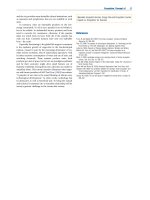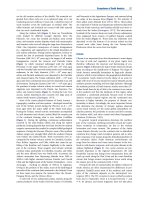Encyclopedia of biodiversity encyclopedia of biodiversity, (7 volume set) ( PDFDrive ) 3256
Bạn đang xem bản rút gọn của tài liệu. Xem và tải ngay bản đầy đủ của tài liệu tại đây (70.39 KB, 1 trang )
Marine Viruses
Family Nodaviridae
There are two genera in the family Nodaviridae. Viruses in this
taxa are generally spherical in shape, (from 25 to 33 nm in
diameter) and lack an envelope and discernible surface
structure. The genome of nodavirids consists of two molecules
of RNA (approximately 4500 nt in total length) that have 50
caps and lack poly(A) tails. Nodavirids are capable of infecting
a variety of insect species including two species of Aedes
mosquitos, in which they cause paralysis and death. Viruses in
the genus Betanodavirus infect and cause disease in marine fish.
Examples include flounder, grouper, and pufferfish, among
others. In addition, several nodavirid-like viruses not yet
approved by the ICTV infect prawns.
Family Togaviridae
This family comprises two genera, the alphaviruses and rubiviruses. While the Alphavirus genus has approximately 40
recognized members, the Rubella virus is the only member of
the Rubivirus genus. The particles of these viruses are enveloped, spherical in shape and have an approximate diameter
of 70 nm. The genome of a togavirid is a single strand of RNA
that is from 7700 to 11,800 nt in length and has a 50 cap and a
poly(A) tail. While most togavirids are transmitted via an
arthropod intermediary, transmission of the alphaviruses that
infect marine mammals and fishes do not appear to require a
vector. Alphaviruses have been isolated that infect elephant
seals, Atlantic salmon, and rainbow trout.
Group V: Negative-Sense ssRNA Viruses
Order Mononegavirales
The Mononegavirales is a large order of negative-sense singlestranded viruses that includes four families, two subfamilies,
and 16 genera. Although the morphology of these viruses can
vary widely (ranging from 80 to 805 nm in size), all virions
are enveloped and most possess spike-like structures that are
involved in attachment to and fusion with the host cell. The
genomes of mononegavirads are linear and nonsegmented,
range from 8900 to 19,100 kb in size, lack a 50 cap and a
poly(A) tail, have a characteristic gene order (wherein from
the 30 end, core protein genes are followed by envelope genes
and then the polymerase), and encode an RNA-dependent
RNA polymerase whose sequence is highly conserved. During
replication, each cistron is transcribed utilizing a stop-start
mechanism starting at a single promotor region located on the
30 end. The Mononegavirales is a taxon of particular relevance
to human health, because it includes virulent human pathogens such as the Ebola virus, rabies virus, and measles and
mumps viruses, but also includes many representatives infecting marine organisms.
Family Paramyxoviridae
The paramyxovirids are viruses of vertebrates that are responsible for notorious diseases in humans and animals such
as measles, mumps, pneumonia, rinderpest, and Newcastle
disease. The family is organized into two subfamilies comprised of seven genera. The virions of paramyxovirids are
spherical in shape and approximately 150 nm in diameter.
The genome of these viruses is a single molecule of negative-
139
sense RNA that can be from 13,300 to 18,200 kb in length. All
genomes of paramyxovirids encode a protein, creatively
named ‘‘F,’’ which causes the fusion of the virus and cell
membranes at neutral pH. An interesting characteristic of the
replication of paramyxovirids is the ‘‘rule of six.’’ This rule
alludes to the fact that the efficiency of RNA replication in
these viruses is severely diminished if the number of nucleotides in the RNA template being replicated is not exactly a
multiple of six. It is believed that the precise packaging requirements of the virus drive this surprising requirement
(Lamb and Parks, 2007). The Cetacean morbillivirus and the
Phocine distemper virus are species in the genus Morbillivirus
that infect marine mammals, while the Newcastle disease virus
has been isolated from the common murre (Lang et al., 2009).
Family Rhabdoviridae
More than 200 different strains of rhabdovirids have been
isolated from plants, invertebrates and vertebrates. The most
distinctive feature of this family of viruses is that they all
possess a bullet or rod-like morphology (Rhabdo from Latin,
rhabdos, ‘‘rod’’) that can be from 100 to 430 nm in size
(Figure 3(j)). The genome of a rhabdovirid is a single
molecule of negative-sense RNA that can be from 11,000 to
14,900 kb in length. Viruses in the genus Novirhabdovirus
infect diverse fishes, including salmon, flounder, and eels.
Two novirhabdoviruses of note, infectious hematopoietic
necrosis virus and viral hemorrhagic septicemia virus, are
responsible for the mortality of significant numbers of wild
and farm-raised salmon each year (Lang et al., 2009). The
rhabdovirid Dolphin rhabdovirus-like virus was isolated
from a white-beaked whale in the North Sea (Bressem
et al., 1999).
Families Not Assigned to an Order
Family Orthomyxoviridae
The virions of orthomyxovirids are enveloped, spherical in
shape, and range in diameter from 80 to 120 nm (e.g.,
Figure 3(h)). They contain a negative-sense RNA genome
composed of six to eight segments of different length that are
in total from 10,000 to 14,700 kb in size. Because of their
ubiquity and virulence, orthomyxovirids have been intensely
studied since the early twentieth century. This research has
resulted in an unprecedented understanding of the mechanisms of zoonosis and evolutionary history of these viruses.
Analyses of genomic data suggest that wild aquatic birds may
be the primary reservoir of the orthomyxovirids that now infect a wide range of vertebrates, including the human-infecting
H1N1 strain responsible for the worldwide human pandemic
of 1918 (Palese and Shaw, 2007). Of the five genera in the
family, the genera Isavirus and Influenzavirus A have viruses
that infect fishes and marine mammals.
Family Bunyaviridae
The family Bunyaviridae comprises five genera whose viruses
infect vertebrates and plants primarily via an arthropod vector.
Among other distinguishing features, bunyavirids have a
genome comprised of three unique molecules of negative or
ambisense ssRNA, that range in total size from 11,400 to
19,200 kb, that encodes four structural proteins. The particles
of these viruses are pleomorphic and range in size from 80 to









